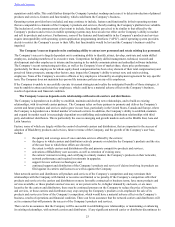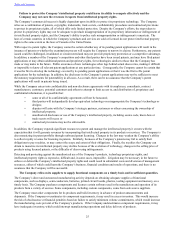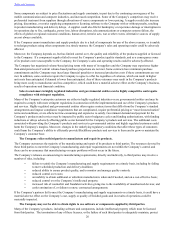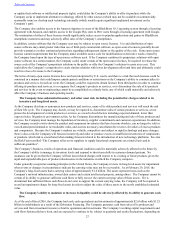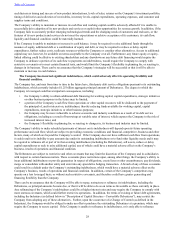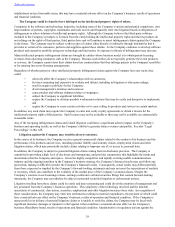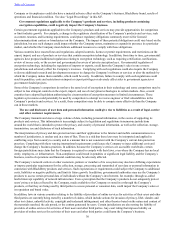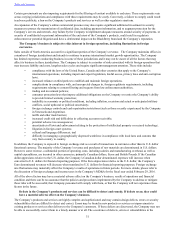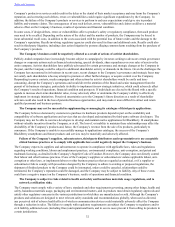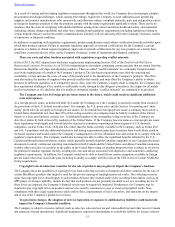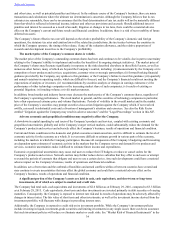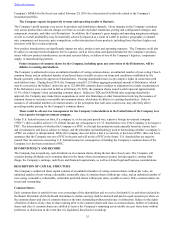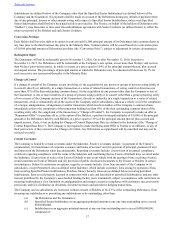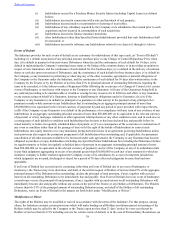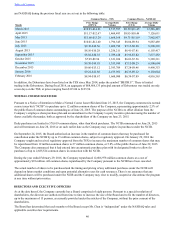Blackberry 2016 Annual Report Download - page 41
Download and view the complete annual report
Please find page 41 of the 2016 Blackberry annual report below. You can navigate through the pages in the report by either clicking on the pages listed below, or by using the keyword search tool below to find specific information within the annual report.
Table of Contents
32
Company’s products or services could result in the delay or the denial of their market acceptance and may harm the Company’s
reputation, and correcting such defects, errors or vulnerabilities could require significant expenditures by the Company. In
addition, the failure of the Company’s products or services to perform to end user expectations could give rise to product
liability and warranty claims. The consequences of any such defects, errors, vulnerabilities and claims could have a material
adverse effect on the Company’s business, results of operations and financial condition.
In some cases, if design defects, errors or vulnerabilities affect a product’s safety or regulatory compliance, then such product
may need to be recalled. Depending on the nature of the defect and the number of products, the Company may be forced to
incur substantial recall costs, in addition to the costs associated with the potential loss of future orders and the damage to the
Company’s reputation. Recalls involving regulatory agencies could also result in fines and additional costs. Recalls could also
result in third-party litigation, including class action litigation by persons alleging common harm resulting from the purchase of
the Company’s products.
The Company’s business could be negatively affected as a result of actions of activist shareholders.
Publicly-traded companies have increasingly become subject to campaigns by investors seeking to advocate certain governance
changes or corporate actions such as financial restructuring, special dividends, share repurchases or even sales of assets or the
entire company. Activist shareholders have publicly advocated for certain governance and strategic changes at the Company in
the past, and the Company could be subject to additional shareholder activity or demands in the future. Given the challenges the
Company has encountered in its business in recent years, recent changes to the Company’s governance and strategic focus may
not satisfy such shareholders who may attempt to promote or effect further changes, or acquire control over the Company.
Responding to proxy contests, media campaigns and other actions by activist shareholders would be costly and time-
consuming, disrupt the Company’s operations and would divert the attention of the Board and senior management from the
pursuit of its business strategies, particularly its ability to implement its new strategic initiatives, which could adversely affect
the Company’s results of operations, financial condition and prospects. If individuals are elected to the Board with a specific
agenda to increase short-term shareholder value, it may adversely affect or undermine the Company’s ability to effectively
implement its strategic iniatiatives. Perceived uncertainties as to the Company’s future direction as a result of shareholder
activism could also result in the loss of potential business opportunities, and may make it more difficult to attract and retain
qualified personnel and business partners.
The Company may not be successful in supplementing or managing its catalogue of third-party applications.
The Company believes decisions by customers to purchase its hardware products depend in part on the availability and
compatibility of software applications and services that are developed and maintained by third-party software developers. The
Company may not be able to convince developers to develop and maintain native applications for BlackBerry 10 smartphones
without valuable incentives from the Company, or at all. The loss of, or inability to maintain these relationships may affect the
desirability of the Company’s products and, hence, the Company’s revenue from the sale of its products, particularly to
consumers. If the Company is unable to successfully manage its applications catalogue, the success of the Company’s
BlackBerry smartphones and future products and services may be materially and adversely affected.
Failure of the Company’s suppliers, subcontractors, third-party distributors and representatives to use acceptable
ethical business practices or to comply with applicable laws could negatively impact the Company’s business.
The Company expects its suppliers and subcontractors to operate in compliance with applicable laws, rules and regulations
regarding working conditions, labour and employment practices, environmental compliance, anti-corruption, and patent and
trademark licensing, as detailed in the Company’s Supplier Code of Conduct. However, the Company does not directly control
their labour and other business practices. If one of the Company’s suppliers or subcontractors violates applicable labour, anti-
corruption or other laws, or implements labour or other business practices that are regarded as unethical, or if a supplier or
subcontractor fails to comply with procedures designed by the Company to adhere to existing or proposed regulations, the
shipment of finished products to the Company could be interrupted, orders could be canceled, relationships could be
terminated, the Company’s reputation could be damaged, and the Company may be subject to liability. Any of these events
could have a negative impact on the Company’s business, results of operations and financial condition.
The Company is subject to risks related to health and safety and hazardous materials usage regulations, and to
network certification risks.
The Company must comply with a variety of laws, standards and other requirements governing, among other things, health and
safety, hazardous materials usage, packaging and environmental matters, and its products must obtain regulatory approvals and
satisfy other regulatory concerns in the various jurisdictions in which they are manufactured or sold. Although the Company’s
products and solutions are designed to meet relevant safety standards and recommendations globally, when used as directed,
any perceived risk of adverse health effects of wireless communication devices could materially adversely affect the Company
through a reduction in sales. The failure to comply with regulatory requirements can subject the Company to regulatory and/or
civil liability, additional costs (including fines) and reputational harm, and in severe cases prevent it from selling its products in
certain jurisdictions.



